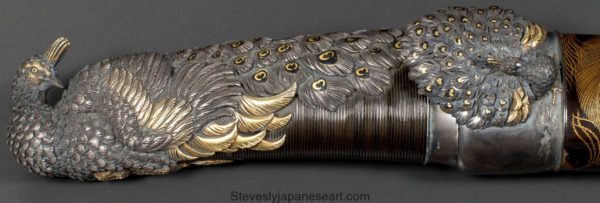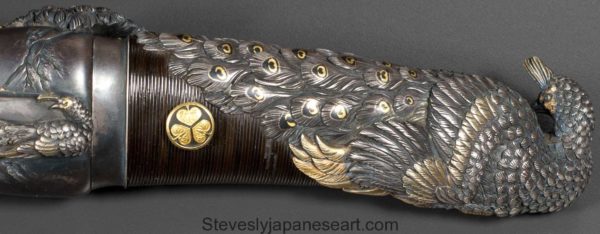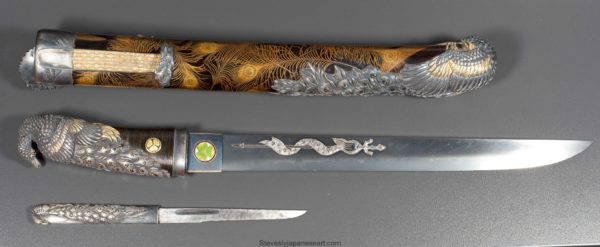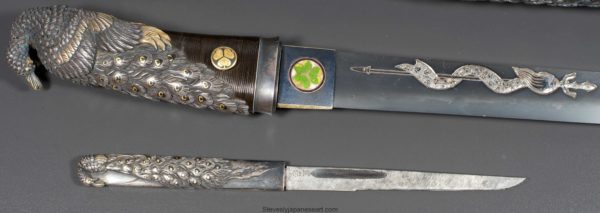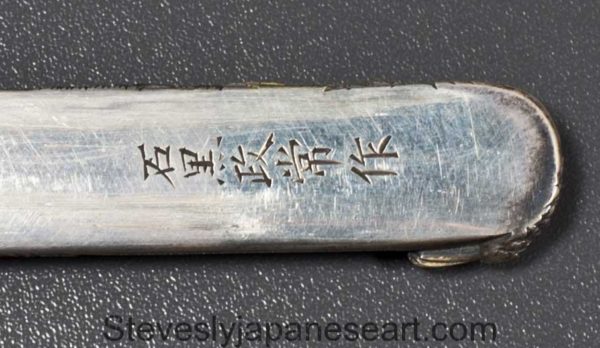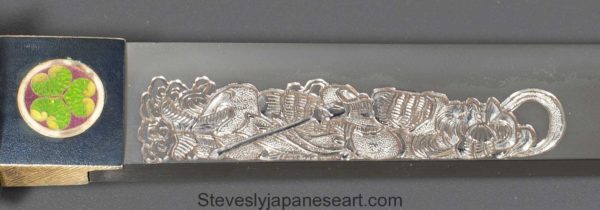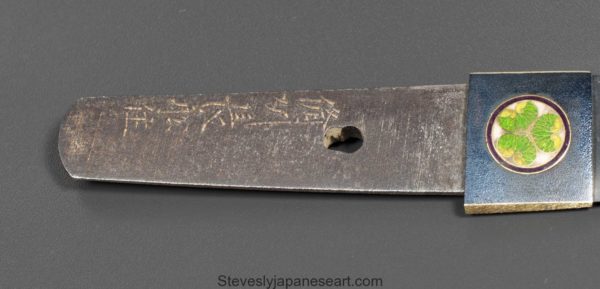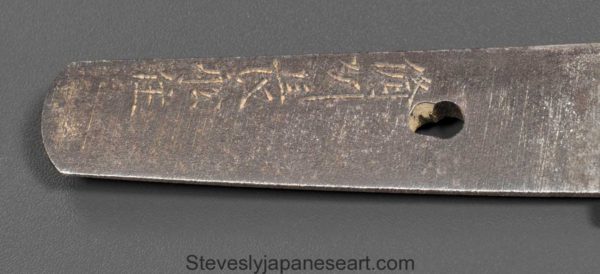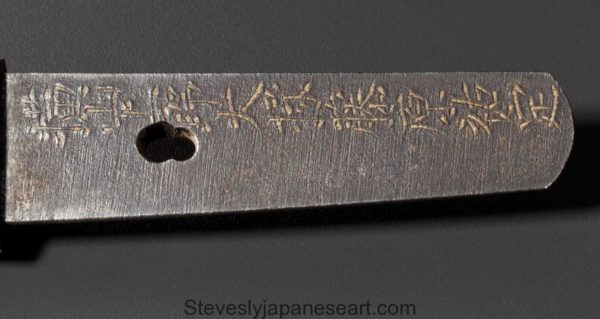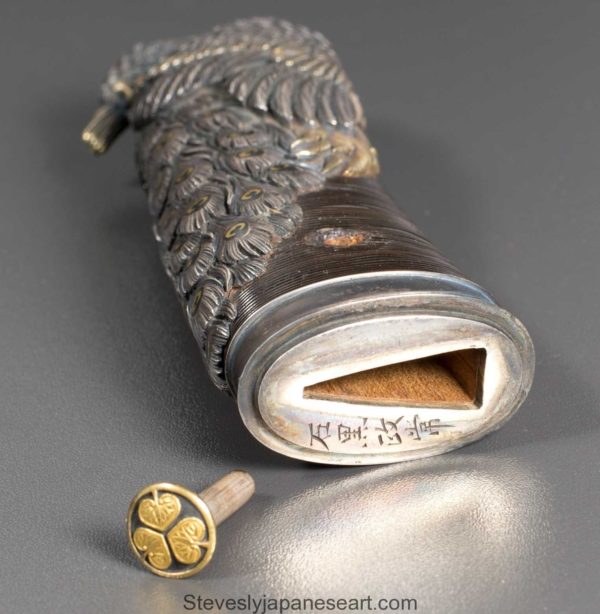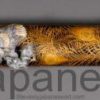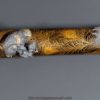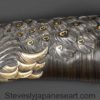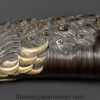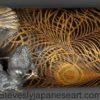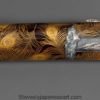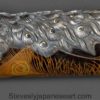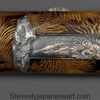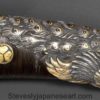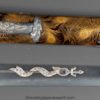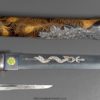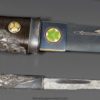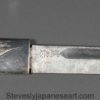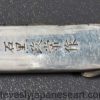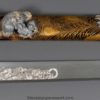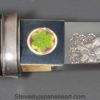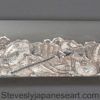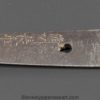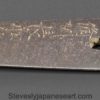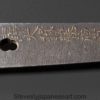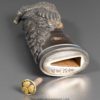As part of our Japanese works of art collection we are delighted to offer this outstanding and rare late Edo period O-Tanto Wakizashi (short sword) the 17th century blade (details below ) has been re mounted towards the end of the Edo period by the highly regarded Masatsune family of metalworkers , the solid silver and mixed metal mountings are of the most sumptuous quality imaginable, the Peacocks envelope themselves around a staggering quality Gold lacquer scabbard decorated with multi coloured Peacock feathers throughout , the Habaki has ben decorated with an enamel mon similar to that used by the Tokugawa family, rulers of Japan for almost two hundred and fifty years , the 17th century blade is fully signed to the Tang ( details below) as are the Kozuka and Kashira, a simply breath taking piece of Japanese craftsmanship from the middle of the 19th century , further attributions documented below .
Notes : Aikuchi Wakizashi O-tanto (49 cm total length)
Aikuchi tanto tang: Inscribed: “備州、長船 住人。横山、上野、大掾、藤原祐定”
“Bishū, Osafune Jūnin. Yokoyama, Kōzuke-Daijō, Fujiwara Sukesada”
Translated: “Fujiwara Sukesada, family name Yokoyama, resident of Osafune in Bishū Province (modern Okayama prefecture), with an official Kōzuke-Daijō title.”
Fujiwara Sukesada was active circa the 寛文Kanbun era (1661-1672) of the Edo period; therefore the sword belongs to the 新刀Shinto sword production period (circa 1596 – 1781).
His given name: Heibei. He was born in Kan’ei 10 (1633) and was granted the title of the kōzuke-daijō in the seventh month of Kanbun 4 (1664) by the lord Ikeda Mitsumasa of the Okayama domain, in the Bizen province (in modern Okayama prefecture). Sukesada’s step-father and son were also sword-smiths.
The image of毘沙門天Bishamonten (Vaiśravaṇa in Sanskrit ), Chief of the Four Heavenly King Generals, is carved as a talisman on the body of the blade.
The Habaki (a wedge shaped metal collar fitted over notch on blade) and scabbard are decorated with a “Tokugawa style” mon.
Silver handle cover: Inscribed 石黒政常Ishiguro Masatsune.
Kozuka: Inscribed by two artists
Inscribed: 石黒政常作Ishiguro Masatsune saku [Made by Ishiguro Masatsune]
Attributed to: Ishiguro Masatsune II.
Masatsune I: 1760-1828. The founder of the Ishiguro School of metalwork. He studied the metal work tradition of the Yokoya School. Edo (Tokyo)
Masatsune II: Son of Masatsune I. Succeeded as Masatsune II in 1829. Active in Tempo 7 (1836). The precise dates of his birth and death are unknown. Edo (Tokyo)
Masatsune III: Adopted son of Masatsune II. No precise dates of his birth and death are known, but he was alive in the Meiji 1st (1868). His signature is rather unique and often used the character 正文 rather than 政. Edo (Tokyo)
The lacquered scabbard with peacock feather design is further enhanced by exceptional three dimensional metal work depicting Peacock, as 孔雀明王Kujyaku Myoo (Sanskrit ): महामायूरी Mahāmāyūrī (Radiant Wisdom Myoo King in Buddhist pantheon), which has the mystical pacifying power to dispel evils and prevent disasters. Dating of the metal sword fittings: circa 1840-1850.
Inscribed: “Umetada 埋忠”
Condition report :
The lacquer and mounts are in magnificent condition as is the blade itself , the item has been sent for light and sympathetic expert cleaning.
Sizes:
Length: 19.25″ 49cm
Free worldwide delivery included in the price of this item .



